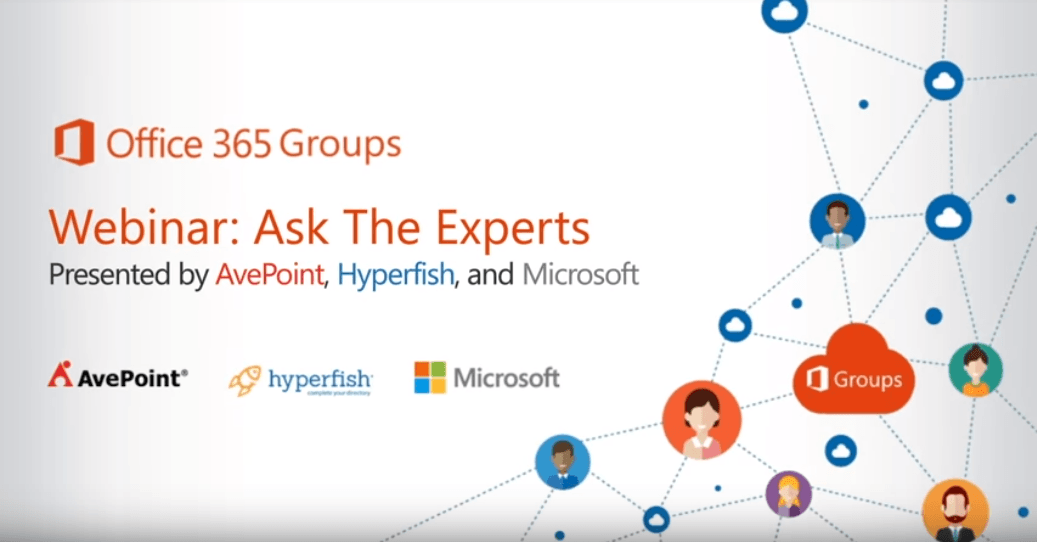Ask The Experts: Understanding Office 365 Groups with Microsoft, Hyperfish, and AvePoint [Webinar]

Need Help Understanding Office 365 Groups? Ask The Experts!
Hi ya’ll! In the past year, there’s been a lot of buzz about Office 365 Groups since all the major announcements at Microsoft Ignite. When understanding Office 365 Groups, there’s no shortage of resources that explain “Groups are shared work spaces where group members can collectively get things done“. But how exactly do Groups work, and how will they enhance the way you work?
Well…We’re here to help!
I’m very, very privileged to have had the opportunity to present an hour long webinar with two of my colleagues and friends from the industry, Christophe Fiessinger from Microsoft and Jeremy Thake from Hyperfish.
Our goal is to help you understand what Office 365 Groups are and the impact that activating them can have on your organization, including the following topics:
- An overview of what Office 365 Groups are, how they work, and what you get when you set one up
- Use cases and customer stories showcasing how you can use Office 365 Groups to power your teams and projects
- Prescriptive advice on how your IT and governance teams can manage Office 365 in the era of Office 365 Groups
Let us know if you found this helpful by continuing the conversation on Twitter by reaching out to us at @cfiessinger, @jthake and @meetdux
Click below for the FREE ON DEMAND WEBINAR
Done understanding Office 365 Groups and looking for best practices and solutions?
With Office 365 Groups, your users are empowered to work together much more effectively. But how do you effectively administer and govern Groups when most controls are left to your end users? We’re here to help:
Join us 11AM EST on Tuesday, February 7 for an interactive question-and-answer webinar where we will cover:
- Key considerations when activating Office 365 Groups
- How to manage the various Office 365 artifacts that come with Groups
- Tips for building a strong Groups governance strategy
- Solutions for regulating Groups creation, management, and end of life
By the end of this webinar, you will understand key considerations when administering Office 365 Groups and how to stay in control with minimal business disruption.
Register Now!
Learn more about Office 365 Groups:
- The Office 365 Groups Playbook
- How to Manage Office 365 Groups Natively
- Office 365 Groups vs Yammer
- Ask an Admin: Day-to-Day Office 365 Groups Administration
- [Video] Behind the Scenes of Office 365 Groups with Microsoft’s Christophe Fiessinger
- Managing Office 365 Groups with Governance Automation Online
- Backup and Restore Office 365 Groups with DocAve Online
- [Video] Provision Office 365 Groups in Policy with AvePoint
- [Video] Backup Office 365 Group Files and Quickly Restore with AvePoint
Transcript from Ask The Experts Webinar: Understanding Office 365 Groups
Dux: Happy Tuesday, everybody. Thank you for joining us. It’s going to be a great hour. My name is Dux Raymond Sy, and I host this “Ask the Experts Webinar” around Office 365 Groups. This webinar is presented by Microsoft, AvePoint, our good friends from Hyperfish. And, boy, this is going to be a jam-packed hour as we unpack and learn everything we can about Office 365 Groups.
Thank you for all that signed up. We have over 1000 people sign on this webinar. We’re broadcasting live on Twitter and Facebook Live. For those that are on Twitter and Facebook Live, you can still jump on and you’re welcome to stay here and watch this too.
This webinar is being recorded. All the resources, questions and answers we’ll provide that soon after the webinar so you can share it with your colleagues as well. So let’s go ahead and get the show started here.
First and foremost, again, my name is Dux Raymond Sy. I serve as the CTO of AvePoint and very, very grateful and privileged to be part of this phenomenal ecosystem in the last 12 years or so, being the Microsoft Regional Director and MVP. I’m very excited to share the next hour with good friends from Microsoft, Christophe Fiessinger, and also Jeremy Thake. So, Christophe, why don’t you introduce yourself?
Christophe: Thank you, Dux, and hello, everyone. My name is Christophe Fiessinger. I’m a Program Manager on the Office 365 Groups Team. And I focus, among other things, Office 365 Groups to service but also delivering an awesome experience in Groups and Outlook.
Dux: Thank you, Christophe, and…
Jeremy: Hi, I’m Jeremy Thake.
Dux: Go ahead, Jeremy.
Jeremy: Sorry, I was jumping to start in, Dux. Hi. Jeremy Thake here. I work for a company called Hyperfish up in Seattle. I used to be at Microsoft for three years in the Office 365 and Azure space. You might have heard of me on the podcast I used to do with Richard diZerega on development. And I was actually at AvePoint before so it’s nice to be back in an AvePoint Webinar.
Dux: Awesome. Thank you, Jeremy. And I’ve got to tell everybody, I’ve known Christophe and Jeremy for a long time. And I remember the first time I met Jeremy. His hopes and dreams was quite different than what he’s doing today but it’s all good. It’s all great. But with that being said, what… Remember, Jeremy, when you told me you wanted to be president?
Jeremy: I did. Actually, that was [inaudible 00:02:23] back in 2009 and I’m not quite sure why but I sort of wanted to be the president of the United States and not probably within reach.
Dux: Hey, buddy, it’s never too late. You’re still young so. So with that, let’s go ahead and jump right on it. So what we’re going to do, I’m going to turn over the stage to Christophe. Christophe will do a good overview and understanding of what Office 365 Groups is all about. How it can help your organization. And then we’ll spend most of our time just discussing what opportunities there are and how we can help our organizations in maximizing Office 365 Groups.
And throughout the session, if you have guys have any questions at all, feel free to pop it in the chat room, on Facebook, or Twitter and we’ll definitely get to it. And we you run out of time, we’ll take all those questions and post it on as a blog-post, along with this recording as well. So with that, Christophe, over to you and I’ll have you take control of the slides.
Christophe: Great. Thank you, Dux. So as Dux mentioned, I wanted to level set your own designing of groups and maybe some of you are using it today. Maybe some of you have attended conferences in the past or have different level of knowledge.
So, the first, hopefully, I will be fairly quick and I will. And I apologize because I really want this to be interactive, as Dux mentioned. And that’s why we got Jeremy and Dux so that they can ask me all the hard questions and do live Q&A. So I’m going to go very fast but hopefully, there’s a lot of content. If you have additional questions, and as Dux mentioned, happy to engage with you guys across social media or others if there’s outstanding questions or requests as you might have.
So the slide I’ll present is typically the first section is why did we build Groups and why this is… What is this all about in the world of collaborations in the enterprise? And then after I’ve presented what Groups is why we built it, then I’ll switch gear and talk a little bit about the technicalities. Since my understanding is most of you are actually professional and technical audience. So I’ll talk about, you know, how can you administer Groups and how does it… What are the different options to manage it within your directory and stuff like that? And then I’ll just wrap up with additional resources that might be useful for you to get started on your journey to leveraging Groups in your Office 365 tenant.
So again, let’s get started. And, typically, you know, starting with the why, hopefully I’m preaching to the choir. But this is a slide we use where, you know, collaboration has changed quite a bit in the workplace. There’s one stat on this slide that say, you know, we need to collaborate more than ever on projects. Obviously, a lot more than five years ago and that’s one of the stats that we have here.
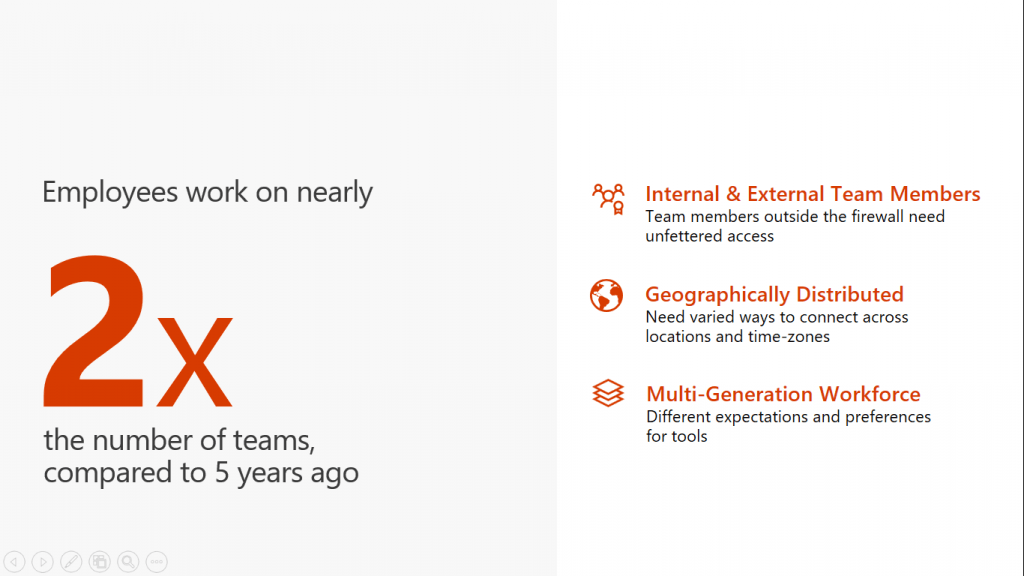
The other thing that we’ve seen in the workplace is there’s a greater diversity than we had in the past. You know, 20% today of the workforce is composed of temporary workers for instance, contractors and freelancers. And I mean those people are not part of your active directory. They’re outside of the HR world and yet, they’re still key members or contributors that might help you on projects and whatever you’re working on as a group.
Geography distributed, you know, typically the stats is 30% of the global workforce now is mobile and 30% of full-time employees actually do most of their work outside of your location. Outside of, sorry, the physical office that the company provides. So again, you know, that’s creating a need from your workforce to be able to be mobile and work wherever they are, and not necessarily be sitting in a cubicle to get work done.
And then the last, which is definitely important, for some of us that have been in the workforce for a while is, you know, there’s different generation, different habits, different maturities. And certainly the millennials that, you know, are the bulk that are coming in in the workforce are a big force in driving change. And have very different expectations in the workforce than let’s say when Christophe or Dux started a couple of years ago. Where we get trained on the one-page memo to make decisions and derive consensus to go about our day-to-day projects. So that’s just a glimpse of, you know, what has changed in the world of collaboration.
And then this next slide talks about not only of those cultural changes and diversity in the workforce. But there’s also different needs that have evolved on how you get work done in an organization, whether it’s large or small, whether it’s commercial, or government, or education. And, you know, this provides, kind of, a panel of some of the key functionality or key tasks that groups need.
And one that’s typically fairly new, that’s fairly hot and a lot of people have questions, is this notion of the chat-based workplace. You know, the idea is I might not have time for asynchronous communication and I need rapid-fire to go back and forth let’s say with Jeremy. And, hey, we’re both working on some code and maybe the build is not working, or it’s breaking, and/or maybe on a code fix or change of hands before I check in my code, yada, yada.
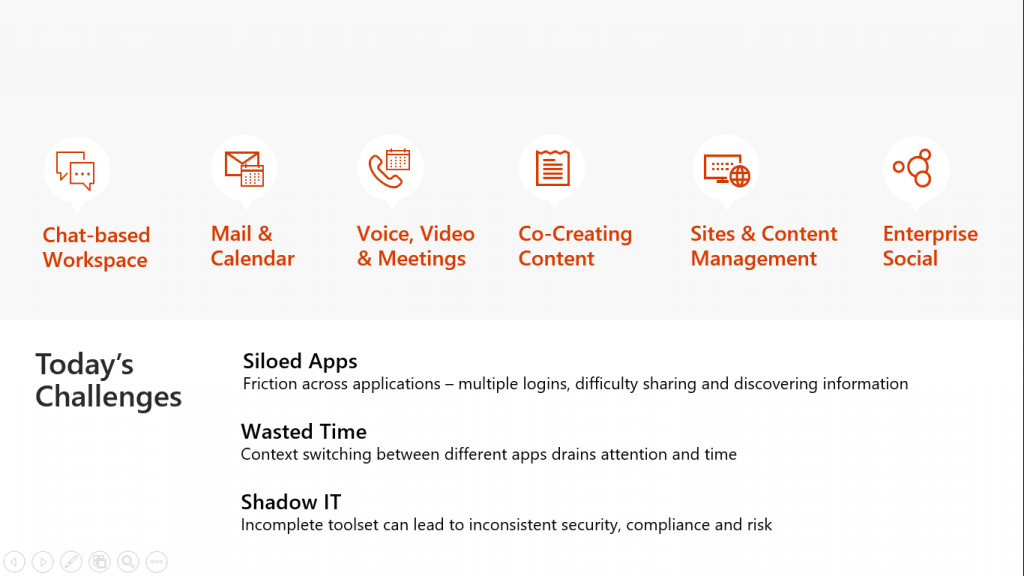
Obviously, mail and calendar, I don’t need to introduce. It’s been around. You know, that’s one of the forms that’s been around the longest. And, you know, we still think there’s a place for the ubiquity of email, the formality that email provides and so forth.
Voice and video, that’s pretty much what we’re doing today whereas we’re real time. Obviously, we didn’t put the webcam on but it’s a very popular way to get work done and collaborate with your colleagues.
Co-creating content, you know, think of it’s great, as a group, to communicate but hopefully, you’re also working on deliverable. Whether it’s sophistication, the deliverable, the price code, the time sheet, whatever it is. Hopefully, you’re producing something to move your company forward, whatever services and products you offer.
Site and content management, think, hopefully, all the intellectual property, the deliverables, the assets that you’re producing. Hopefully, there’s a life cycle around it and you manage those and think of that bubble responding to that need.
And enterprise social, it’s something, you know, that’s risen. You know, it started about eight years ago, which is the whole notion of reaching out throughout the organizations. You know, you’re breaking silos. It doesn’t matter if you’re a new hire or if you’re the president, if you’re in engineering or sales. But various topics that spans your entire organization where you want everyone’s potential eyes, and opinions, and ideas, and make sure everyone notices or potentially can provide help.
Now in addition to those different needs that groups have today, there’s definitely additional challenges that we’ve seen and, you know, siloed apps create friction. You know, you have different notifications, different credentials, different security and compliance. And I know probably a lot of you have to deal with that on a day-to-day basis. And typically going hand with that is this notion of shadow IT. Which is, hey, an employee today with any device, you know, their favorite iPhone or whatever smart phone that they have, they can pretty much… If the tool that’s provided by the organization doesn’t fulfill their needs, they can pretty much download the app of choice that they think meets their need, and invite their colleagues and contractors, and go about doing their business without asking anyone’s approval. Certainly [inaudible 00:09:58] of our employers know IT. And this is definitely a challenge in the enterprise today, again, with the proliferation of smart device.
Now, this leads us into the next slide, which is okay, what are we doing in Microsoft from an Office 365 perspective, which is our productivity suite? And can you guys still hear me?
Dux: Yes, we can hear you.
Christophe: Hello, hello?
Dux: Loud and clear. Hey, Christophe, we can hear you loud and clear.
All right. So while, I think, Christophe is kind of signing back in, I think just to pick up on where he’s going with this. Is from a Microsoft perspective, Office 365 as you’ve seen in the last five years, I think, is how old Office 365 is. Is providing a lot of different methods, and tools, and capabilities to addressing needs or styles of different groups of people.
Recently, we saw Microsoft Teams. We had a great blogpost about that. We have great webinar about that to provide that gap around chat-based workspace. You know, Microsoft is still leading and continuing to invest around mail and calendaring through Outlook and Exchange Online. And we’ve seen the growth and innovation around Skype. One of the most exciting things around Skype, especially in the Office 365 GovCloud last week or… Yeah, it was last week or two weeks ago was officially… The E5 is now officially available, the E5 SKU for the GovCloud which, obviously, Skype is a big part of it for voice communication.
Content and co-creation, with Office 365 Pro Plus both on the desktop for Office and also obviously online. The ability to co-create content with different capabilities such as co-authoring or even jumping into teams and working on documents. And later on, we’ll talk more about Groups. The ability to work on content with Groups, and Teams, and SharePoint, and OneDrive. All that has been certainly made available throughout the platform.
Editor’s Note: Another free webinar available for you to learn from Microsoft, Dux, and Avanade all about Microsoft Teams, Office 365 Groups vs Teams, and when to use Office 365 Groups vs Team sites.
https://www.avepoint.com/blog/strategy-blog/microsoft-teams-webinar-2016/
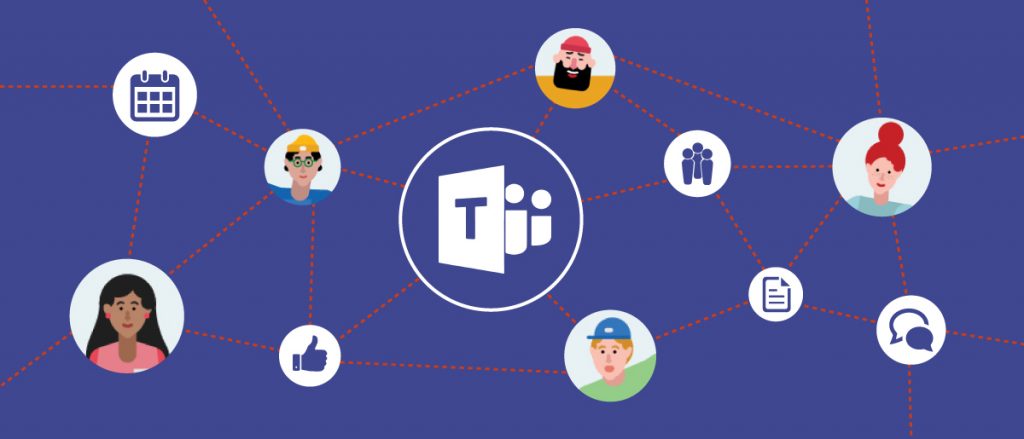
With sites and content management, SharePoint which has been around for a while. But the continuous innovation on that with the recent announcement of the modern Team sites and the SharePoint development framework so we can continue to enhance that…
Christophe: Okay.
Dux: Hey, Christophe, you’re back.
Christophe: I’m back. Sorry about that.
Dux: Okay.
Christophe: Yeah, can you hear me?
Dux: Yeah, we can hear you and then enterprise social… I kind of went through the different offerings Microsoft has. I stopped at the enterprise social.
Christophe: Okay. So I apologize for that. We went to a backup plan and good old landline. So, hopefully, Dux presented my slides but seriously… So I talked about the why and, you know, here’s how we’re addressing those different needs for different groups. And, you know, we’ve talked about chat-based workplace. And think of a Microsoft Team, which we just announced last November, which we’ll release the first quarter of this year.
Obviously, mail and calendar, you know, think of Outlook and all its endpoints where it’s the rich desktop, the browser form or the mobile app. Think voice and video to address that need or solution is obviously Skype for Business. Co-creating content, think of Office Pro Plus which is or desktop apps, you know, streamline to your favorite device if you will. Or this other browser version over desktop apps.
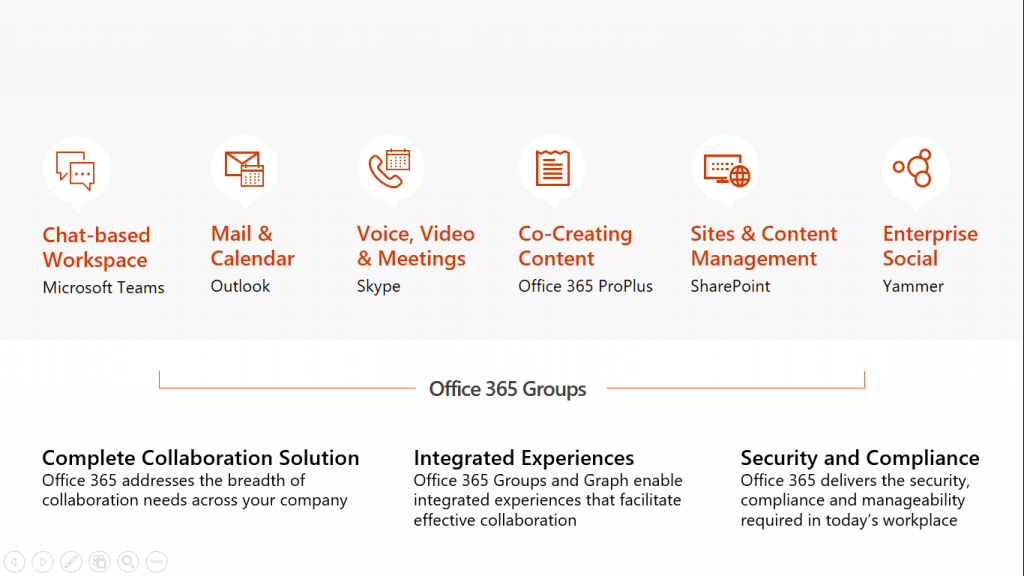
And then to store all the content, you know, the solution for that is SharePoint. I want to stress that because sometimes people confuse OneDrive for business. So basically, we say OneDrive for Business is more for your personal file even though you can do some lightweight collaboration. But [inaudible 00:13:58] through enterprise content management and the rigor that typically a company needs, the answer to store your content is in SharePoint online.
And then enterprise social, you know, we’ve acquired Yammer, I think, almost five years ago. And, you know, that’s our solution to reach out to the enterprise. And, you know, wherever we have a community of interest, or a community of practice and you want to tap the collective knowledge then for that, you know, the sweet spot is to leverage Yammer.
Now, all those applications and services are built on a common fabric and that’s what the Office 365 Groups provide. You know, it gives you the ability to go from one app to another with a single membership across the suite.
Now moving forward to double-click on what Office 365 Groups is, let me again explain. Since sometimes, I see a little confusion of people confusing the membership service on the individual app. And this slide gives you a little overview where, you know, again Group is a membership service. So typically, you think of the life cycle a user comes in. You know, Groups is self-service by nature and they start in the app of choice, whatever they’re trying to do. They can start in Teams, they can start in Outlook, they can start in SharePoint. Soon, they’ll be able to start in Yammer or they can already today leverage Planner, for instance. And they create a group within those apps.
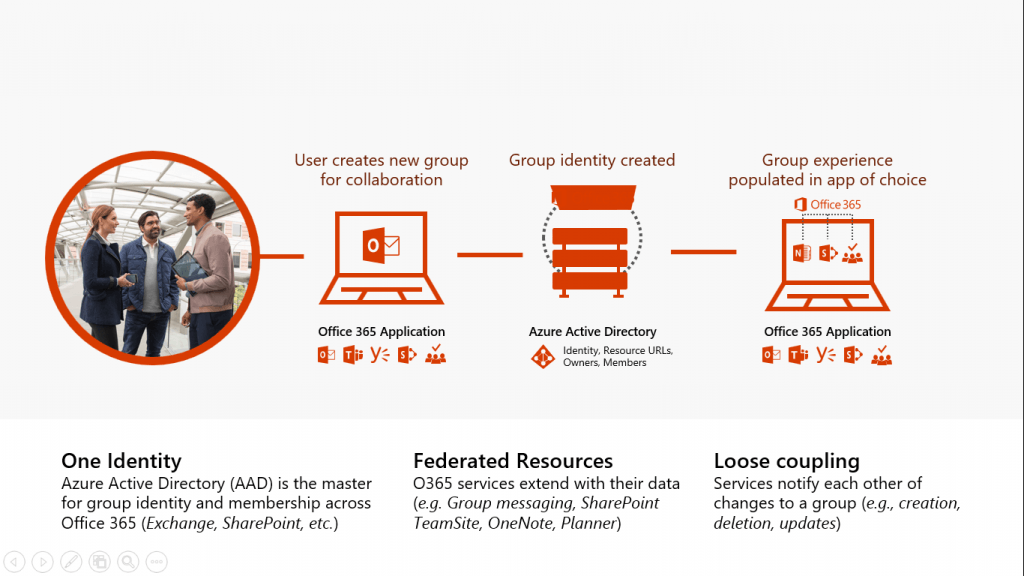
What happens in the back-end is we’ll actually make a call to Azure Active Directory where we create that container, which is the group. And, you know, it has a name, it has descriptions, it has a logo. And more importantly, it has a set of members and, you know, there’s two types of members. There’s just owners, typically the person who created it and members as part of the group. And once that’s created, then, you know, you can go in the application again that you started and go back about doing your business. Whether you’re using a Board and Planner to do whatever breakdown structure of your project or wherever you start some back-and-forth chat in Teams and so forth.
So that’s the high level. Obviously, this happens in seconds and again, what I want to stress is don’t confuse Groups to service on the individual app that are built on top of Groups. And that’s what kind of like the bottom of the slide stresses. You know, you get one identity for the Groups. The Master is Azure Active Directory and it has all those properties and it kind of does the handshake with all the application. You know, if you’ve created a group in Outlook and you want to store content, then in the backend, we’ve already provisioned a full team site for that group. So that, you know, when you’re ready to upload a document then you can do so, and you don’t have to worry about creating the team site or vice versa. That’s what we mean by a set of resources.
So all those Groups get a common set of resources whether it’s a SharePoint team site, or OneNote to do note-taking, or whatever ideation, all the great things you can do with OneNote. You know, a common set of project management tool which is Planner and, obviously, different group messaging options whether you’re using Outlook, Teams, or Yammer.
Editor’s Note: if you have questions about Microsoft Teams, you’re not alone. Check out our frequently asked questions “FAQ” blog from our webinar with Microsoft’s Matt Berg, Avanade, and Dux.
https://www.avepoint.com/blog/technical-blog/microsoft-teams-faq/

The other point is there’s some loose coupling. So when you create things let’s say you create a team site, there is… You know, it’s not instantaneous but there’s a little bit of latency between all the other workflows or provisions. You can go about your business to work with SharePoint and hopefully, shortly thereafter, you do have to SHAREit inbox if you want to start emailing the groups. And that there’s constantly that back and forth between Azure Active Directory and all the workload depending on what you’re doing with the group. So that’s the high level of Group membership service.
Not Understanding Office 365 Groups, Here’s More Options:
- 5 Steps to Configure Hybrid Features in SharePoint 2016 Beta 2
- 4 Most Exciting SharePoint 2016 Features for End Users
- 5 Reasons You’ll Love Hybrid in SharePoint 2016
- What’s Next for SharePoint in 2017 with Microsoft’s Mark Kashman [Video Interview]
With over 20 years of business and technology experience, Dux has driven organizational transformations worldwide with his ability to simplify complex ideas and deliver relevant solutions. He serves as the Chief Brand Officer of AvePoint who has authored the LinkedIn Learning course How to Build Your Personal Brand, the book SharePoint for Project Management, as well as numerous whitepapers and articles. As a public speaker, Dux has delivered engaging, interactive presentations to more than 25,000 people at leading industry events around the world. He also hosts the modern workplace podcast #shifthappens that focuses on how leading organizations navigated their business transformation journey. Dux advocates tirelessly for inclusion, using technology for good, and philanthropic initiatives. Connect with him: http://dux.sy

